The deceased and their status in the military conflict
According to the Natalia Estemirova Documentation Center Database (hereinafter the Database), the total number of victims killed in the context of the armed conflict is at least 5,181.[1] This number does not include victims that have disappeared.
Among the victims were civilians, military and law enforcement officers as well as members of the armed forces (see chart 1):
- 3,272 civilians;
- 1,160 military personnel, including those locally recruited and seconded from other regions of Russia;
- 339 militants; and
- 410 victims whose status was unclear due to lack of information.
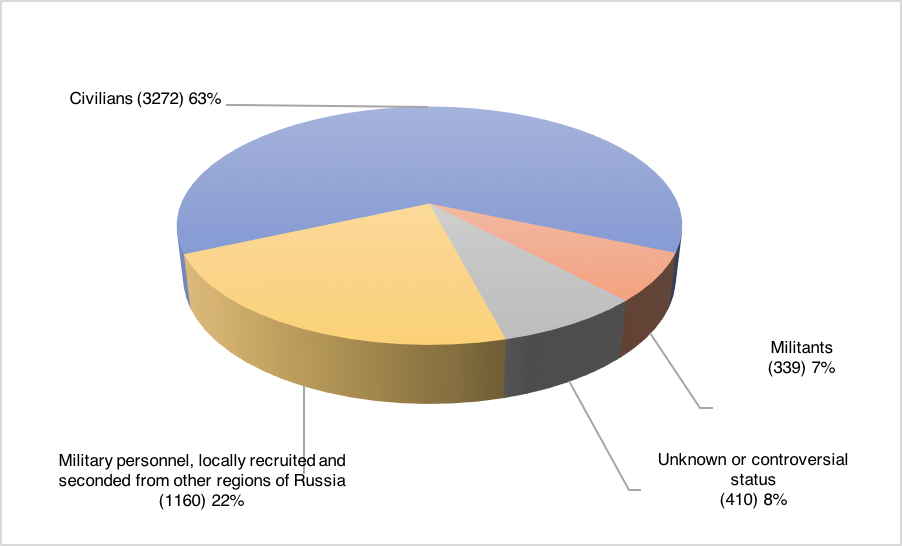
Circumstances of death
Information relating to the role and belonging/legal status of the deceased in the varying circumstances is best reflected by the figures displayed in the following table: [2]
| Civilian population | Military personnel | Militants/irregular fighters | Unknown or controversial status | |
Bombardments and artillery shelling | 712 | 15 | 8 | 10 |
Sweeping operations (zachistkas) | 863 | 111 | 162 | 87 |
Armed clashes | 23 | 357 | 196 | 38 |
Clandestine (terrorist) attacks | 126 | 305 | 6 | 6 |
Landmine explosions | 145 | 16 | 3 | 11 |
Death from the use of military equipment | 37 | 99 | 0 | 5 |
Death caused by other circumstances | 1 137 | 486 | 48 | 229 |
The term “clandestine attack” refers to two kinds of attacks. The first are so-called sabotage attacks which are unexpected and ambushed attacks directed against the military aims of an enemy. The second type are terrorist attacks which according to international law, and different from sabotage attacks, are aimed to deter and intimidate civilians and can be committed by state agents.[3] Thus, terrorism pursues a particular aim; to spread terror among the public and to intimidate an indefinite number of people. Additionally, while both terrorism and sabotage attacks are committed unexpectedly, the latter are aimed at combatants and military objects.
It is noteworthy, however, that the Russian mass media and authorities have used the term ‘terrorist attack’ to refer to all types of attacks committed, which have also included those directed against military objects and combatants. Such representations attach a general and vague meaning to the two definitions which are in fact fundamentally different.
To provide some examples of such attacks, on 10 October 2002 at 18.00 an explosion took place during a leadership meeting on the third floor of the Zavodskoy District Office of the Interior (ROVD) building in Grozny. The extent of the explosion was such that two floors of the four-story, reinforced concrete building were almost destroyed. All those present in this part of the building (including the entire leadership team) were trapped under the rubble. Efforts to extract the bodies continued in to the night and until the following morning, by which time 17 individuals had died and a further nine wounded.[4]
On 27 December 2002, a vehicle equipped with explosives broke into the territory of the Government House in Grozny taking the lives of 72 people.[5] A similar incident took place on 9 May 2004 at the Dynamo stadium in Grozny.[6]
Cases of accidental or intentional driving over by military vehicles on people, including representatives of the authorities were also quite often. For example, on 22 August 2004, an armored personal carrier (APC) of federal forces hit a VAZ car on the Rostov-Baku highway. This resulted in the death of a traffic police officer from the village of Goity in the Urus-Martanovsky District.[7]
In another case, on 6 October 2000 at noon, in Grozny, an ACS (self-propelled artillery installation) crushed a civilian car belonging to a local resident. Three members of his family – his wife, 29-year-old pregnant daughter and two-year-old granddaughter – were all in the car. His daughter and his granddaughter died immediately. His wife was hospitalized with severe injuries. At the time of the crush, the car was parked near the ruins of their house which the father of the family was inspecting. He was not in the car and therefore survived. Witnesses claim that the accident was not accidental: the driver went out of the column and deliberately sent the ACS to the car parked on the side of the road. [8]
In another case, an APC of the federal forces hit a Gazel car carrying five passengers. As a result, two passengers in the Gazel were killed: a young boy of 20 and his 16-year-old sister. According to a bystander, the APC had hit the Gazel minibus when it had pulled to the side of the road to give way to the military. An eyewitness claims that the driver of the APC and three military men were intoxicated during the incident.[9]
Means and methods of causing death
The prohibition of the means or methods of warfare that cause excessive suffering is a general principle of international humanitarian law.[10] Yet despite this principle, the torture and beatings of victims causing excessive suffering and often resulting in their death was widely used throughout the Russian-Chechen conflict.
A total of 113 victims who were killed as a result of cruel treatment are registered in the Database; 85 of these were civilians.
One such example took place when a local resident from the village of Geldagan in the Kurchaloyevsky District was taken from his house by the military in February 2003. He was held for two days at the local Federal Security Service Directorate (UFSB), where he was hung from the ceiling with his arms and legs tied together, and beaten with a piece of pipe and fittings. He was kept in a drafty and unheated room with concrete floor all night long. Three days later and notwithstanding any medical treatment, he died as a result of the injuries sustained. [11]
It was also common practice to torture combatants who had surrendered to the Russian troops which often resulted in the death of the victim. For example, in March 2000, in the village of Goy-Chu (also known as the village of Komsomolskoye) following an armed clash between the military and fighters, a large number of fighters surrendered to the military. Many of those who had surrendered were transported to a military base in the village of Khankaly, where they were kicked and beaten with rifles and batons. They were also tortured using electric shocks, and were denied water, food and access to medical care. They were also kept in overcrowded cells with no fresh air and as a result, the wounds they had sustained began to fester. At least nine people died as a result.[12]
Women and the elderly were no exceptions to receiving such treatment. For instance, it has been established that two individuals, a man and a woman over 60, died as a result of beatings received from the military and representatives of OMON (Special Purpose Mobile Units). [13] In total, at least four women became victims of beatings leading to death.
Among the methods used to kill individuals with particular cruelty was the use of sharp and cutting objects. There are 206 victims in the Database whose corpses were found at least with stab wounds.
Other cases exhibited shocking displays of cruelty where victims were simultaneously cut and beaten. One example, which reveals the appalling extent of the methods and means of torture, is the case of a resident from Urus-Martan who was detained at night in his house during a special operation, and whose body was found five days later a few kilometers from the city. The victim’s cervical vertebrae were broken, his throat was cut, his body was pierced with a metal object. Bruises and burns were found on his body, his fingernails had been pulled out, he had knife wounds on his back and shoulders, two front teeth had been smashed, he had suffered an impaling chest wound from a sharp object, his genitals had been partially cut off, and bones in his arms and legs were broken. There was also the trace of a close range gunshot wound on his skull behind his ear. It should also be noted that the clothes the victim had worn when he was abducted – a leather jacket, sweaters and trousers – had been removed, and he was instead dressed in camouflage pants. [14]
In another incident, local residents were horrified to find a decapitated head impaled on a stake on a gate near the local administration building in the village of Mesker-Yurt. That same day, on the outskirts of the village, the body of Mr S.S. was found.[15] His skin had been partially torn off. According to one source, the young man was killed on suspicion of his cooperation with the federal forces. According to other sources, however, “the reason for the murder was his refusal to pay contributions to insurgents as well as criminal activity in the petroleum business.”[16]
The database contains information on at least 61 victims whose bodies were found decapitated. Of these, 55 were men and six were women. 46 victims were between the ages of 18 and 60 at the time of their murder, and at least five victims were over the age of 60. The ages of ten of the victims remain unknown.
The bodies of 14 victims were found bearing signs of electric shock.
At least 37 victims were burned alive. Often, victims would be burned alive in their own homes. For example, on 10 August 2005 at around midnight, the house of a resident of the village of Dyshne-Vedeno in the Vedensky District was attacked. Eight fighters entered the premises and seized the owner and tied her to a bed with adhesive tape. The attackers then dowsed the rooms of the house with petrol and set it alight, leaving the woman tied to the bed. They claimed that the old woman had been cooperating with the federal authorities, and that her grandson was working with the police. [17]
In another case, on 20 April 2001 in Grozny, three students, whom the Russian military had tried to detain the day before but had been unsuccessful due to the intervention of teachers and classmates, were burned alive in a car adjacent to one of the educational buildings. The car was initially shelled using machine gunfire and explosive bullets. The driver was somehow able to get out of the car, but was pushed back in by the attackers who subsequently closed the doors and set the car alight. The car burst into flames while the three victims had still been alive inside, as was established by the position of their corpses. [18]
In another case, in the Achkhoi-Martanovsky District, fighters from the gang of the famous field commander Arbi Barayev blew up an “Ural” service car belonging to the Voronezh OMON in the Achkhoi-Martanovsky District of Chechnya. The driver of the truck, though experienced, was unable to escape from the burning car due to multiple injuries and died in the fire. [19]
Another 18 victims were found with, among other injuries, signs of suffocation. The bodies of at least two of these victims also had signs of fatal gunshots to the head. Often, suffocation was used as an additional method of torture to the cruel means described above. Generally, besides suffocation marks, the victims’ bodies also displayed numerous signs of beatings, stab wounds and incision wounds.
Extrajudicial killings
The Database also contains cases of extrajudicial killings. These crimes were usually committed in circumstances where the victim was under the physical control of the offender(s), or where the victim was more vulnerable; for instance, a pregnant woman or a child.
The key factor in determining extrajudicial killings for the purposes of the Database was the probability that the offender had the intention to cause the death of the victim, and that the victim most likely had no possibility to defend themselves. Situations in which individuals, often men, were taken away following sweeping operations (zachistkas) and subsequently found dead, did not always fall within this category. However, situations in which, for example, a group of military personnel or fighters had stormed into a house and killed the victims in front of their family members were included. In such situations, it was highly unlikely that any of the civilians were able to effectively defend themselves against a group of armed individuals whilst fearing the fate of their families.
One of the most striking examples of an extrajudicial killing was the murder of a man in the middle of the street in the village of Akhkinchu-Borzoy in July 2009. The officers of the Kurchaloyevsky District Department of Internal Affairs had stopped a car, in which a father and his 17-year-old son were returning home, at a checkpoint. According to several young witnesses and local residents, security forces had thrown the father, heavily beaten, in front of them at night. He was being asked if he had helped the fighters. He shook his head to indicate a negative response and was asking the security forces to release his son. The security forces then shot the victim in front of the witnesses saying: “This is what happens to those helping the fighters!”[20]
In another case, following a terrorist attack in the village of Iliskhan-Yurt in May 2003, a large group of armed men in camouflage uniforms and masks forcibly entered the house of the relatives of two sisters who were suspected of committing a crime. The armed men subsequently shot four people: two men aged 38 and 41 who were both the sons of one of the sisters, as well as the sisters’ 62-year-old brother and his 25-year-old daughter. The family members who survived the attack stated that the criminals had spoken in Chechen without an accent.[21]
A total of 1,192 cases of such extrajudicial killings are documented in the Database. Of these, at least 146 victims are women.
At the time of their murder, at least 100 victims were over the age of 60 and at least 35 victims were under the age of 18. Eight of the victims were under 14 years of age and 27 victims were between 14-17 years old (chart 2).
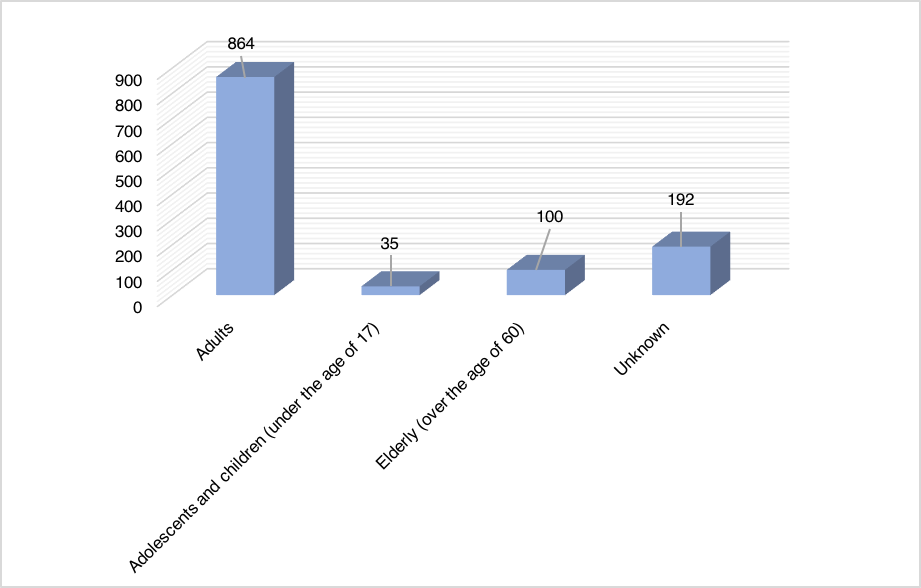
It must also be mentioned that of the victims of extrajudicial killings, at least five were pregnant women, 29 had a disability at the time of their murder and 23 were ill with various diseases (chart 3).
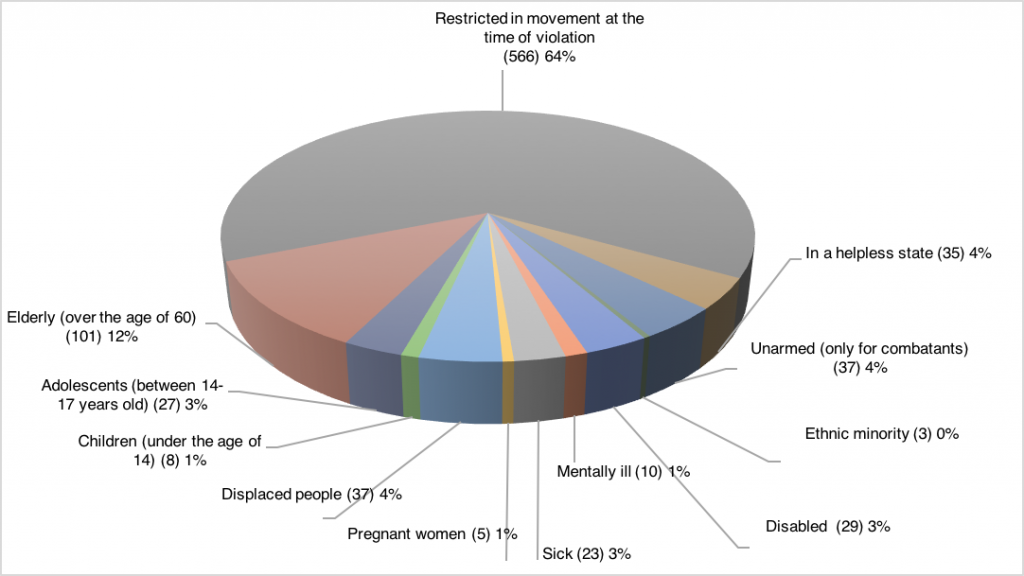
The relevant statistics were updated on 18 March 2019.
The data is subject to change in view of the ongoing work by the Natalia Estemirova Documentation Center on the search and identification of victims of the armed conflict.
Media library
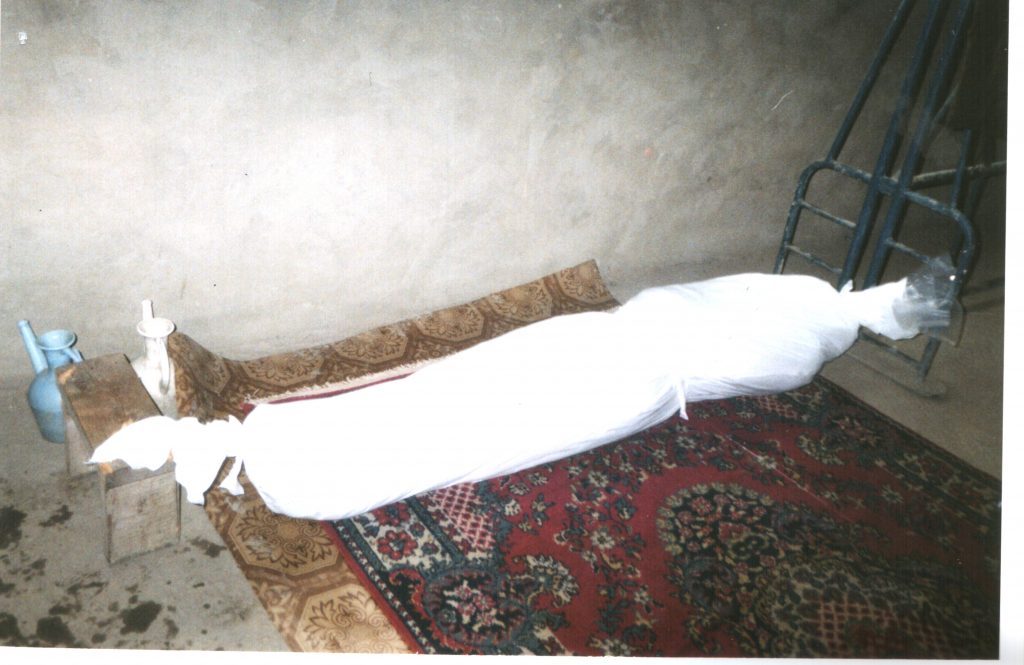
NEDC document 33814 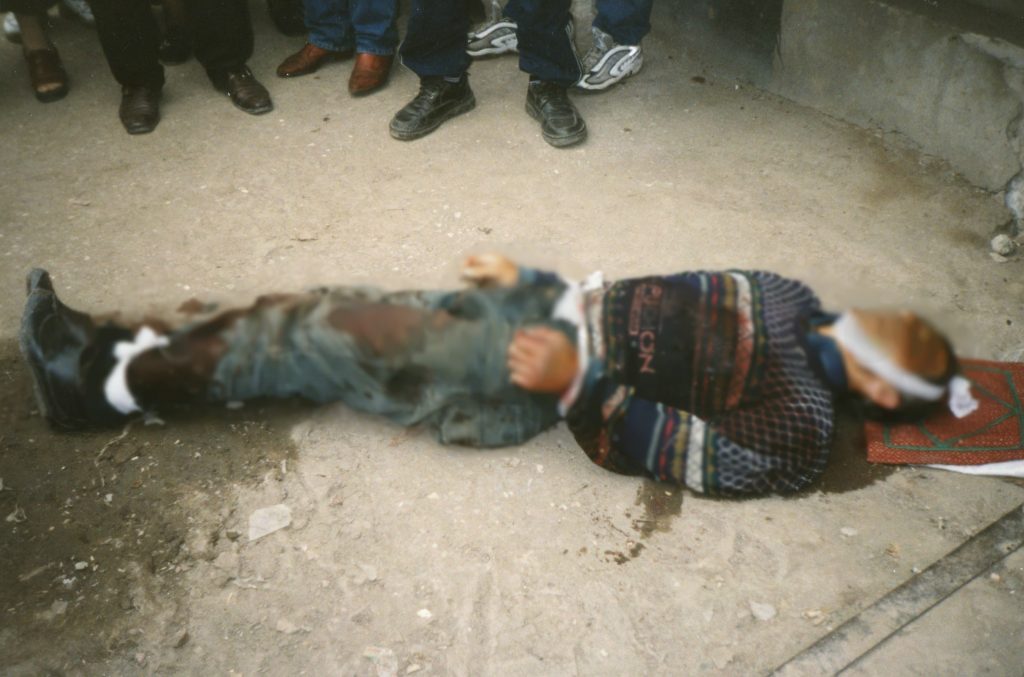
NEDC document 31675 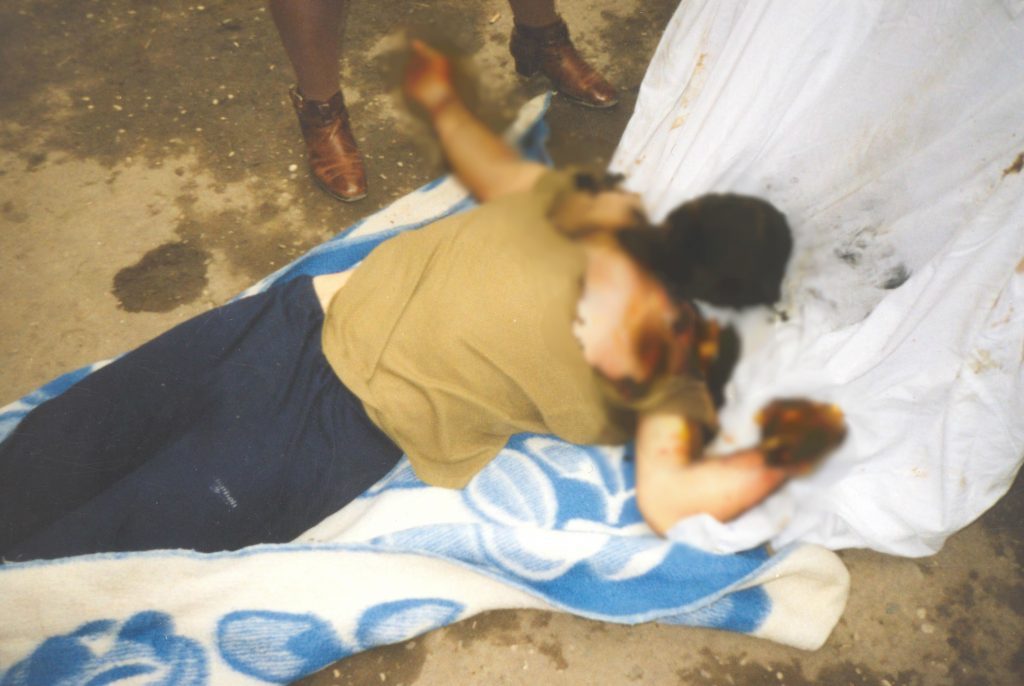
NEDC document 32154 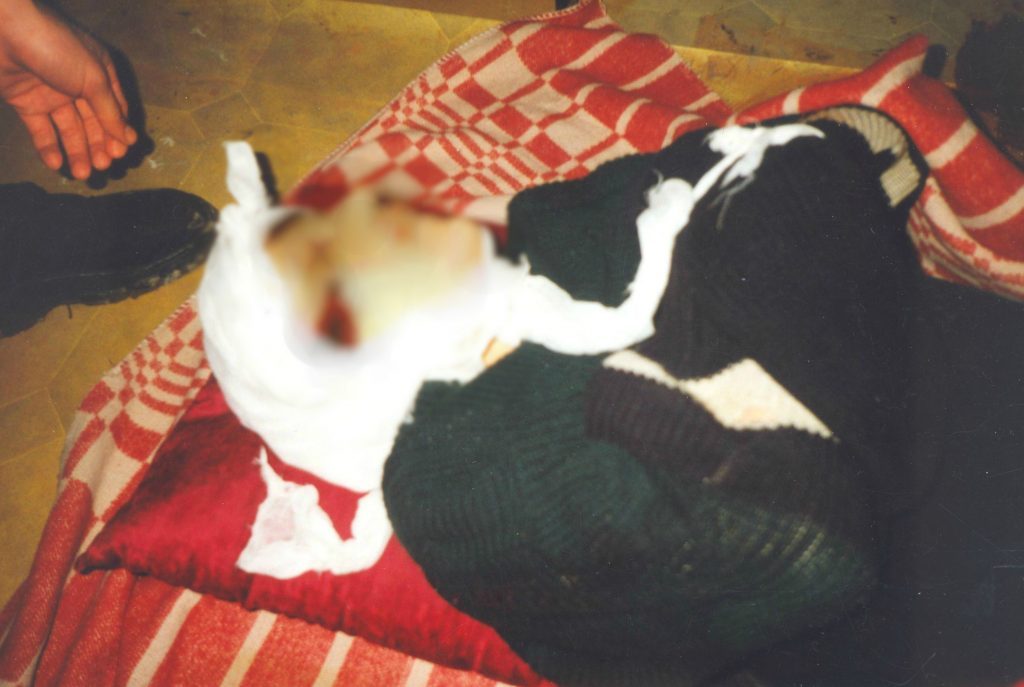
NEDC document 32155 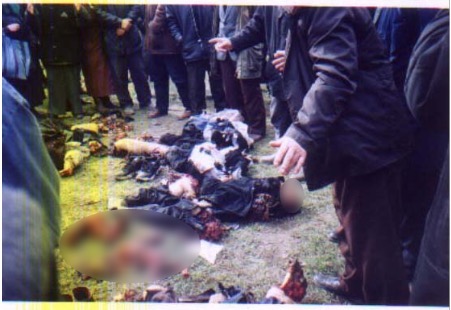
NEDC document 32120 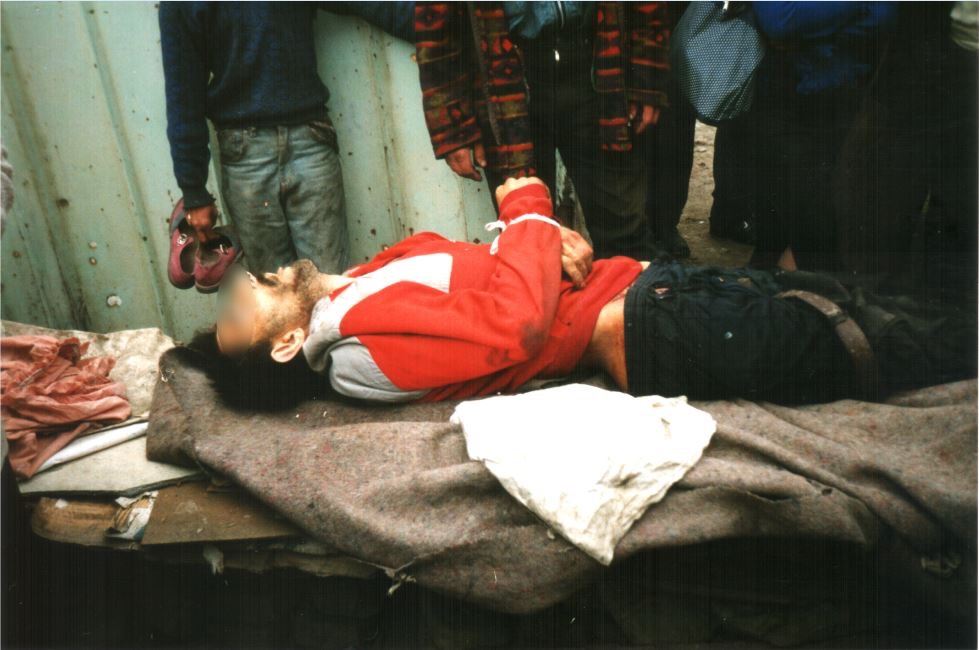
NEDC document 31679
References
[1]The statistics do not include residents of Chechnya who had been abducted in neighboring regions, as well as residents of Ingushetia, Dagestan and other republics of the North Caucasus, who have been victims of abductions and unlawful detentions in connection with the armed conflict in Chechnya. The Database mainly contains information about violations committed during the period of the second armed conflict that started in 1999. However, it also contains sporadic facts recorded during the first armed conflict.
[2]These figures are not mutually exclusive, meaning that a person could, for example, become a victim of a mine explosion during a zachistka.
[3]ICTY, Prosecutor v. Galic, Case No. IT-98-29-T, Judgment of 5 December 2003, §133.
[4]Incident № 180 «Explosion in Zavodskoy district of Grozny, October 10, 2002».
[5]Incident № 567 «The explosion of the Government House in Grozny, December 27, 2002».
[6]Incident № 247 «The explosion at the stadium Dynamo, May 9, 2004».
[7]Victim № 43643.
[8]Incident № 5596 «The death of family members T-ovi in Grozny as a result of an accident, October 2000».
[9]Incident № 317 «Accident in the village Chishki, July 2006».
[10]International Committee of the Red Cross (ICRC). Database on international humanitarian law. «Rule 70. Weapons of a Nature to Cause Superfluous Injury or Unnecessary Suffering», https://ihl-databases.icrc.org/customary-ihl/eng/docs/v1_cha_chapter20_rule70.
[11]Victim № 49575.
[12]Incident 312 «Incidents in Goy-Chu (Komsomolskoye), March 2000».
[13]Victims №№ 50637, 50594.
[14]Victim № 47100.
[15]Victim № 70590.
[16]Victim № 70590.
[17]Victim № 55362.
[18]Incident № 909 « The shooting of students of Grozny, April 18-20, 2001».
[19]Victim № 57491.
[20]Incident № 5833 «Detention at a checkpoint in Dzhugurty, July 2009».
[21]Incident № 274 «The shooting of Sh. B. family members in Bachi-Yurt, May 2003».
